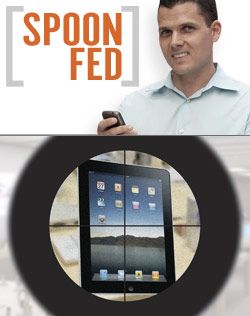5 Ways to Challenge the iPad

Earlier this week I asked four prominent analysts if any tablet coming to market—the Dell Mini 5, HP Slate, Notion Ink Adam, JooJoo, etc.—has a shot at taking on the iPad. If you’re the competition, you might be depressed by their answers. One said, “It doesn’t feel that way,” another said Apple “could create a commanding lead,” and another said it’s the “completeness” of Apple’s solutions that set the company apart. One analyst even said that the iPad “has a good two-year lead.” Combine these quasi-eulogies with the prediction from iSuppli that iPad sales will hit 7 million this year (triple that figure by 2012), and it sounds like the tablet war is already over, right? Not if the makers of these devices follow my five tips.
1. Think twice about full Windows
Based on our reviews thus far of Windows 7 tablets, it’s clear that there is a difference between supporting touch and being optimized for that kind of input. Even when vendors supply their own touch software, it feels like a weak walled garden. And when you leave that suite of half-baked apps you still have to deal with an OS that was designed for a cursor instead of your finger. While Windows 7 is certainly snappier and less resource-intensive than Vista, the overhead of a full-blown desktop OS seems like overkill on the lower-cost tablets we’ve tested. HP may prove me wrong with whatever software it adds on top of Win7 for its Slate, but here’s my general advice: go with Android or Chrome, or wait for Microsoft’s Courier OS to emerge (assuming it’s real).
2. Provide a one-stop entertainment shop
This week I reviewed the HTC HD2, a new smart phone from T-Mobile that comes stocked with Blockbuster for movies, MobiTV for watching your favorite shows, Barnes & Noble for reading eBooks, and Slacker for music. Why am I talking about a phone? Because this 4.3-inch slate reminds me of the iTunes advantage. With a single account you can download apps, books, movies, music, and TV shows. That’s why I think it’s smart that Dell is reportedly partnering with Amazon for all of the above (except apps) for its upcoming 5-inch tablet. I’m not saying a choice of content providers is bad. However, consumers appreciate the simplicity of being able to get all their entertainment goodies in one place.
3. Don’t build your own app store
Whenever an upstart tablet or eReader vendor tells me it’s going to build its own app store, I can’t help but roll my eyes (on the inside). There’s no way you’re going to get software developers to devote resources to your single product. HP is the biggest PC company in the world, and yet the app selection for its TouchSmart desktop and Tablet PCs, which have been on the market for a couple of years, will be blown away by the iPad on day one. So unless Microsoft is serious about rolling out its own app store—something I said they should do months before the launch of Windows 7—it will be up to manufacturers to either convince Google to allow their devices to use the Android Market or rely on more robust web apps.
Stay in the know with Laptop Mag
Get our in-depth reviews, helpful tips, great deals, and the biggest news stories delivered to your inbox.
4. Define your target market
Don’t make a tablet because everyone else is. Think long and hard about the technologies or applications that are going to make your product stand out. For example, the Notion Ink Adam could give the iPad a run for its money in the reading department because of its Pixel Qi display, a unique screen that has an ePaper and full-color mode. Other tablets will focus on home use. For example, the OpenPeak OpenTablet from AT&T will tie in with home security systems and energy consumption monitoring apps, as well as provide access to a home dashboard. Some will choose to differentiate based on price, but that alone won’t ensure success in what promises to be a hyper-competitive market.
5. Connect Wireless to the Home Theater
One of the coolest demos I saw at this year’s CES was WHDI, which stands for wireless home digital interface. It’s a technology that tries to do what Intel’s Wireless Display does—output whatever is on your computer’s screen to your big-screen TV with the push of a button—but it offers full 1080p resolution instead of 720p. I’m glad many of the iPad alternatives have HDMI ports, but if the idea of a tablet is to provide a laid-back experience it would be much cooler to be able to stream what you’re watching or playing to your home theater setup wirelessly from the sofa. WHDI products will be limited at first to external boxes that plug into PCs, such as the ASUS Eee WiCast kit, but I’d like to see some tablet maker (ASUS?) roll this technology, or the next version of Intel’s WiDi, directly into a tablet.
Editor-in-chief Mark Spoonauer directs LAPTOP's online and print editorial content and has been covering mobile and wireless technology for over a decade. Each week Mark's SpoonFed column provides his insights and analysis of the biggest mobile trends and news. You can also follow him on twitter.

